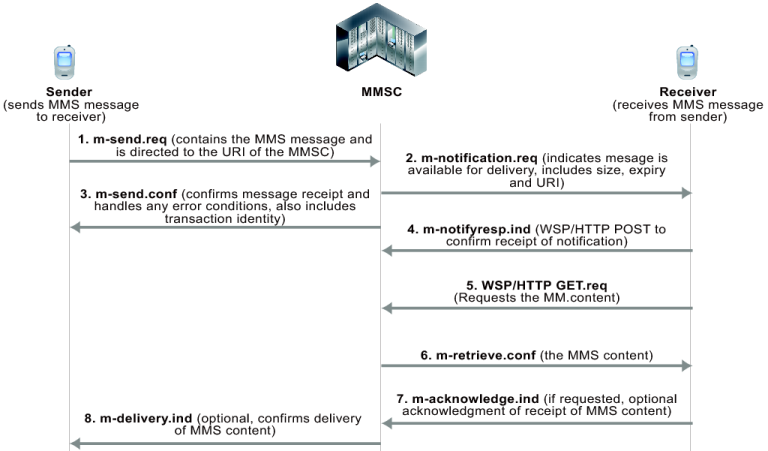How MMS content interfaces are applied
As shown in
Figure 133, the sender’s mobile device encodes the MMS content in a form similar to MIME email message (MMS MIME content formats are defined by the MMS Message Encapsulation specification). The encoded message is then forwarded to the service provider’s MMSC. Communication between the sending device and the MMSC uses the MM1 content interface. The MM1 content interface establishes a connection and sends an MM1 send request (
m‑send.req) message that contains the MMS message. The MMSC processes this request and sends back an MM1 send confirmation (
m-send.conf) HTTP response indicating the status of the message — accepted or an error occurred, for example.
Figure 133: MM1 transactions between senders and receivers and the MMSC
If the recipient is on another carrier, the MMSC forwards the message to the recipient's carrier. This forwarding uses the MM4 content interface for forwarding content between operator MMSCs (see
Figure 134).
Before the MMSC can forward the message to the final recipient, it must first determine if the receiver’s handset can receive MMS messages using the MM1 content interface. If the recipient can use the MM1 content interface, the content is extracted and sent to a temporary storage server with an HTTP front-end.
To retrieve the message, the receiver’s handset establishes a connection with the MMSC. An HTTP get request is then sent from the recipient to the MMSC.This message contains the URL where the content of the message is stored. The MMSC responds with a retrieve confirmation (m-retrieve.conf) HTTP response that contains the message.
Figure 134: MM4 messages sent between operator MMSCs
This causes the receiver’s handset to retrieve the content from the embedded URL. Several messages are exchanged to indicate status of the delivery attempt. Before delivering content, some MMSCs also include a content adaptation service that attempts to modify the multimedia content into a format suitable for the recipient’s handset.
If the receiver’s handset is not MM1 capable, the message can be delivered to a web based service and the receiver can view the content from a normal Internet browser. The URL for the content can be sent to the receiver in an SMS text message. Using this method, non-MM1 capable recipients can still receive MMS content.
The method for determining whether a handset is MMS capable is not specified by the standards. A database is usually maintained by the operator, and in it each mobile phone number is marked as being associated with a legacy handset or not. It can be a bit hit and miss since customers can change their handset at will and this database is not usually updated dynamically.
Email and web-based gateways from MMSC to the Internet use the MM3 content interface. On the receiving side, the content servers can typically receive service requests both from WAP and normal HTTP browsers, so delivery via the web is simple. For sending from external sources to handsets, most carriers allow MIME encoded message to be sent to the receiver's phone number with a special domain.


